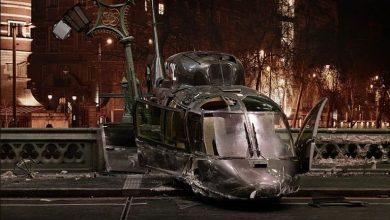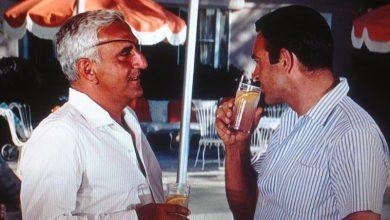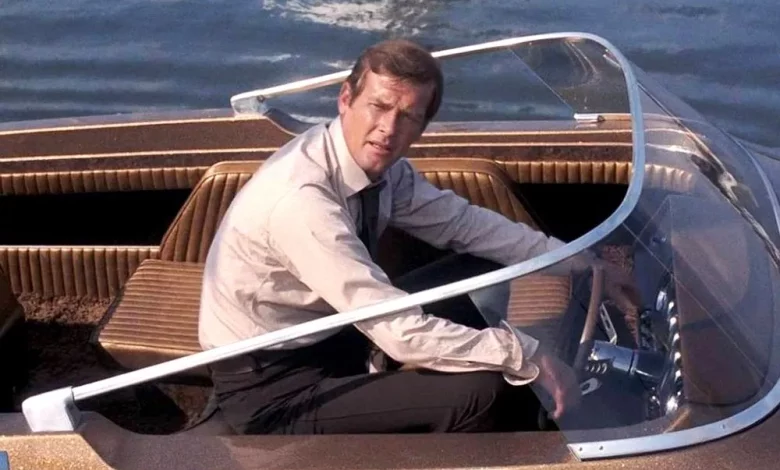
Welcome to the fascinating world of the Glastron GT150 speedboat, immortalized in the thrilling James Bond film “Live and Let Die.” In this article, we delve into the iconic chase scene through the Louisiana marshes, where the GT150 showcased its incredible performance and made a record-breaking jump. We’ll explore the behind-the-scenes details, modifications made to the boat, and the legacy it has left behind. Get ready to embark on an adventure filled with high-speed pursuits and cinematic excitement!
Key Takeaways
- The Glastron GT150 played a prominent role in the James Bond film “Live and Let Die,” where it was featured in a thrilling chase scene through the Louisiana marshes.
- The GT150 used in the famous jump scene underwent modifications, including the addition of black rails for stability and center steering for perfect balance during the leap.
- The filmmakers faced challenges during practice jumps, almost leading to the cancellation of the jump scene. However, with the help of calculations from Tulane University, the jump was executed flawlessly.
- After the production of “Live and Let Die,” some GT150s were sold as “used” boats, while others were returned to Glastron or sold through local dealerships.
- The popularity of the GT150 skyrocketed after the film’s release, and it became an iconic symbol of high-performance speedboats.
Live and Let Die: The Epic Chase through Louisiana Marshes
In the iconic 1974 James Bond film, “Live and Let Die,” audiences were captivated by a thrilling chase scene featuring the legendary Glastron GT150 speedboat. This high-speed pursuit through the mesmerizing Louisiana marshes showcased the GT150’s incredible capabilities, culminating in a record-breaking 120ft jump that left viewers on the edge of their seats.
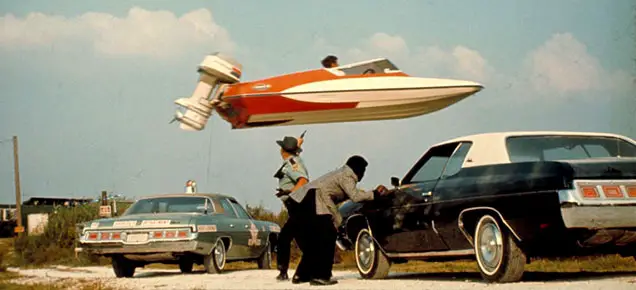
The Live and Let Die GT150: A Marvel of Engineering
The Glastron GT150 used in the memorable jump was meticulously crafted in 1972 and boasted an impressive Evinrude Starflite 135hp engine. To ensure stability during the jump, two small black rails were added to the hull, effectively keeping the boat level side to side on the ramp.
To maintain perfect balance during the leap, the GT150 underwent modifications, including placing the steering wheel in the center instead of the usual right-hand position. This adjustment allowed for precise control, enhancing the safety and success of the daring stunt. The jump was meticulously rehearsed over 100 times to ensure every detail was perfected before filming.
It’s fascinating to note that Glastron produced and sold a total of 26 boats to the film company specifically for the production of “Live and Let Die.” These boats played various roles throughout the movie, adding to the overall excitement and adventure.
Beyond the GT150: Bond’s Pursuit Continues
After James Bond was forced to leave behind the GT150, he seamlessly transitioned to another remarkable vessel during the chase—a white and gold Glastron CV-19 Jet Speedboat. This shift in boats added a new dynamic to the pursuit, showcasing the versatility and power of Glastron’s impressive lineup.
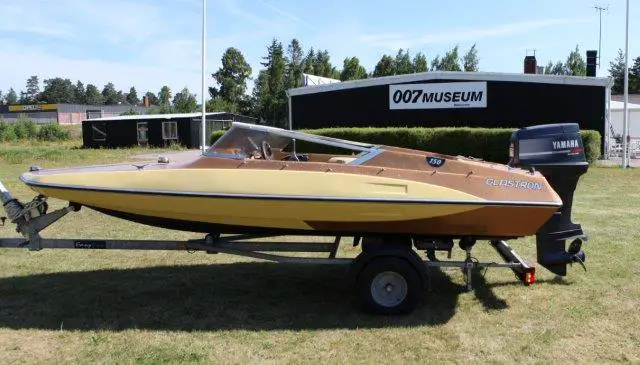
Unveiling the Secrets: Insights from the Ian Fleming Foundation
The Ian Fleming Foundation, the proud owners of the actual jump boat GT150, has shared some intriguing details about the boats used during the filming of “Live and Let Die.” Here are some fascinating facts:
- Boat Selection: Out of the 26 Glastron boats used in the film, approximately nine were GT150s. It’s worth noting that not all of these GT150s were pristine 1972 versions. Some may have been 1971 models or slightly imperfect 1972 models. Only two boats needed to be new and camera-ready for the film sequences.
- Verification and Documentation: The only way to confirm whether a Glastron boat is truly from the movie is through a bill of sale from the production company. Unfortunately, all Glastron records from that period were destroyed, making it challenging to authenticate the boats’ origins.
- Center Steering Modification: Only two GT150s were equipped with center steering, a center seat, and wood hull skids for filming purposes. However, only one of these modified versions was used in the film, while the other served as a backup and did not make an appearance. The remaining GT150s were primarily used for test jumps.
- Steering Reversion: One of the GT150s with center steering was eventually restored to its original configuration, with right-hand steering, and subsequently sold. The second GT150, seen in the film with center steering and a single seat, suffered damage and was sold “as-is.”
- Practice Jump Challenges: Many of the practice jump GT150s faced damage or even sank during the preparation phase. The difficulties encountered during these practice jumps nearly led to the cancellation of the famous jump scene. The filmmakers sought the expertise of Tulane University to calculate essential factors such as speed and balance, ensuring the success of the final jump.
- Perfect Execution: Based on Tulane University’s recommendations, the filmed jump scene took place on October 16th, 1972. The calculations and preparations paid off, as the jump was executed flawlessly, becoming the only jump filmed and included in the movie.
- Boat Distribution: Some of the GT150s survived the filming and were sold as “used” boats by the production company. The remaining boats were either returned to Glastron in Austin or sold through local dealers. Unfortunately, no serial numbers for the sold GT150 boats are currently known, except for the record-setting boat used in the jump scene.
- The Record-Breaking GT150: The GT150 responsible for the record-breaking jump received repairs for minor fiberglass stress cracks in front of the windshield. It has been accounted for and can be observed on tours worldwide. The current owner conducted repairs in 1996, preserving the boat’s legacy.
- The Second Jump Boat: The boat that followed the GT150 during the chase did not break or tie the GT150’s record of 110ft. Although it didn’t achieve the same level of notoriety, it still played an essential role in adding excitement to the film.
- Damage and Loss: Out of the 26 boats used during the production, 17 suffered damage, including several GT150s. Furthermore, three Glastron CV-19s were damaged during the filming of the lawn skidding wedding scene due to collisions with trees. It is estimated that six CV-19s were used, but none have been located or officially verified to date.
- Mysterious “Billy Bob” Boats: At least two of the elusive “Billy Bob” boats mentioned in connection with the film existed and were used during production. However, their whereabouts remain unknown.
- Boat Sales: Initially, the film crew had the first opportunity to purchase the used boats after filming. Subsequently, the remaining boats were sold to the general public. Some GT150s were likely sent back to Austin, possibly due to excessive damage, or sold through local dealerships.
- The GT150 Legacy: The popularity of the Glastron GT150 skyrocketed after the movie’s release, leading to numerous sales of the boat. However, it’s important to note that most, if not all, GT150s sold after the film’s debut were 1973 versions. Glastron’s new 1973 model year began shortly after filming in October 1972, preceding the movie’s release in June 1973.
- GT150 Production Details: The record-breaking GT150 used in the film was manufactured on August 24, 1972, and sold immediately after filming concluded on October 16, 1972.
- Bonus Features: The latest enhanced DVD version of “Live and Let Die” includes scenes from the practice jumps and other exciting outtakes, providing a unique glimpse behind the scenes.
- Authenticity and Documentation: All the Live and Let Die boats were sold with accompanying documentation from the production company, providing a valuable historical record. When considering the purchase of a “movie set” boat, ensure that you have the boat’s documentation rather than relying solely on anecdotes.
- Serial Numbers: While only the serial number of the record-setting GT150 from the jump scene is known, there are a few rare instances where James Bond Live and Let Die boats have verified serial numbers. These verified boats serve as exceptional collectibles for enthusiasts.
- The Record-Breaking GT150 Today: The GT150 responsible for the record-breaking jump was last sold in 1996, ultimately finding its way to New York. Today, it continues to captivate audiences at special events and can be observed on tour at www.ianflemingfoundation.org.
- Film Poster Tribute: The movie’s poster prominently features several Glastron GT150-inspired boats. While not exact replicas of the GT150, these boats boast a similar color design and shape, paying homage to the iconic speedboat.

FAQ:
1. How many Glastron GT150 boats were used in the film “Live and Let Die”?
In the filming of “Live and Let Die,” a total of 26 Glastron boats were utilized, and approximately nine of them were GT150s. However, it’s worth noting that not all of these GT150s were pristine 1972 versions. Some may have been from the previous year or slightly imperfect 1972 models. Only two boats needed to be brand new and ready for filming.
2. Were all the GT150s modified with center steering for the jump scene?
Out of the two GT150s that had center steering, a center seat, and wood hull skids for filming, only one of them was actually used in the movie. The other modified version served as a backup and did not make an appearance. The remaining GT150s were primarily used as test jumpers to ensure the success of the daring stunt.
3. How did the filmmakers overcome the challenges faced during practice jumps?
The practice jumps for the GT150s encountered numerous difficulties, leading to damages and even sinking of some boats. These challenges almost resulted in the cancellation of the iconic jump scene. To overcome these obstacles, the filmmakers sought assistance from Tulane University, which provided expert calculations regarding speed, balance, and other essential factors. The collaboration with Tulane University proved successful, as their mathematics and recommendations were crucial in executing the jump perfectly in the final filmed scene.
4. What happened to the GT150s used in the film after production?
Following the production of “Live and Let Die,” some of the GT150s used in the movie were sold as “used” boats by the production company. The remaining boats were either returned to Glastron in Austin or sold through local dealerships. Unfortunately, the exact whereabouts of these boats are currently unknown, as no comprehensive records exist, except for the record-setting boat used in the jump scene.
5. How many boats were damaged during the filming of “Live and Let Die”?
Out of the 26 boats used in the production of “Live and Let Die,” a total of 17 suffered damages. This included several GT150s, highlighting the intense action and risks involved in the filming process. The challenges faced during the lawn skidding wedding scene, which involved collisions with trees, resulted in damage to three Glastron CV-19s.
6. Are any of the Glastron CV-19s used in the film still in existence?
To date, none of the Glastron CV-19s used in “Live and Let Die” have been located or officially verified. It is estimated that around six CV-19s were used during filming. The absence of these boats adds an air of mystery to their current whereabouts and status.
7. Who had the opportunity to purchase the used boats after filming?
Initially, the film crew had the first chance to purchase the used boats after the completion of filming. Once the crew had made their selections, the remaining boats were sold to the general public. This gave enthusiasts and fans the opportunity to own a piece of cinematic history.
8. Did the popularity of the GT150 increase after the film’s release?
Yes, indeed. Following the release of “Live and Let Die,” the popularity of the Glastron GT150 skyrocketed. The boat’s appearance in the movie further heightened its appeal and made it even more sought-after among boating enthusiasts. However, it’s important to note that most, if not all, of the GT150s sold after the movie’s debut were 1973 versions, as the new model year began shortly after filming concluded.
9. Is the record-breaking GT150 still in existence?
Yes, the record-breaking GT150 used in the jump scene is still in existence. It was last sold in 1996 and was discovered and purchased in New York. The boat has been meticulously preserved and can be seen on tour at special events, captivating audiences with its remarkable history and significance in the world of James Bond.
10. Are there any other films that feature the Glastron GT150?
While the Glastron GT150 gained widespread recognition for its appearance in “Live and Let Die,” it also made an appearance in the 1977 film “Outlaw Blues.” This further solidified the boat’s status as an iconic vessel in the world of cinema, showcasing its enduring appeal and versatility beyond its association with James Bond.
Conclusion
The Glastron GT150 has etched its name in cinematic history through its unforgettable appearance in “Live and Let Die.” From the thrilling chase through the Louisiana marshes to the jaw-dropping record-breaking jump, the GT150 showcased its exceptional performance and captured the imaginations of audiences worldwide. Its enduring legacy as a symbol of speed and adventure lives on, making it a coveted piece of boating history. So, hop aboard and experience the excitement of the Glastron GT150, a true icon in the world of James Bond and beyond.


